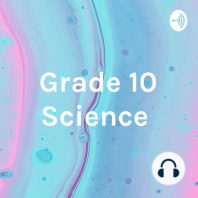4 min listen
Carter Germain Carbon 14
ratings:
Length:
3 minutes
Released:
Nov 22, 2021
Format:
Podcast episode
Description
Script:
Carbon-14 has been described as one of the most important isotopes and has revolutionized science. These claims of Carobn-14 were made by Martin Kamen in 1939, during the time of his unslept weeklong experiment. Kamen worked day and night with no sleep conducting an experiment where he had bombarded a piece of graphite with subatomic particles to try and find new forms of carbon, forms of carbon that could have particular uses. He indeed did discover carbon- 14.
Generally, carbon has a average atomic mass of 12.0107 u and carries 6 neutrons, 6 protons, and 6 electrons. Carbon 14 carries 8 neutrons, 6 protons, 6 electrons, and has a half life of 5,730 years, +/- 40 years. It decays from carbon 14 to nitrogen 14 due to beta negative decay. Carbon-14 is sourced naturally primarily from cosmic ray action on nitrogen in the atmosphere and is often found in atmospheric carbon dioxide because it is being constantly produced in the atmosphere.
The reason why Martin Kamen said that carbon-14 could be one of the most important isotopes, is because of its main application- dating, measuring the age of plants, animals, and other certain archaeological artifacts. Radiocarbon is present in molecules of atmospheric carbon dioxide and enters the biological carbon cycle. It is absorbed from the air by green plants and then passed on to animals through the food chain. Radiocarbon decays slowly in a living organism, and the amount lost is continually replenished as long as the organism takes in air or food. Once the organism dies, however, it ceases to absorb carbon-14, so that the amount of the radiocarbon in its tissues steadily decreases. Because carbon-14 decays at this constant rate, an estimate of the date at which an organism died can be made by measuring the amount of its residual radiocarbon. The discovery of radiocarbon dating was made by Willard Libby and was awarded the Nobel prize in 1960 for his contribution to revolutionizing science.
But another revolution is needed. Due to the burning of fossil fuels, tests of nuclear bombs, and other global issues such as climate change, the amount of carbon- 14 in the air has been altered greatly. As a result, conversion tables are needed that match up calendar dates with radiocarbon dates in different regions.
Carbon-14 has been described as one of the most important isotopes and has revolutionized science. These claims of Carobn-14 were made by Martin Kamen in 1939, during the time of his unslept weeklong experiment. Kamen worked day and night with no sleep conducting an experiment where he had bombarded a piece of graphite with subatomic particles to try and find new forms of carbon, forms of carbon that could have particular uses. He indeed did discover carbon- 14.
Generally, carbon has a average atomic mass of 12.0107 u and carries 6 neutrons, 6 protons, and 6 electrons. Carbon 14 carries 8 neutrons, 6 protons, 6 electrons, and has a half life of 5,730 years, +/- 40 years. It decays from carbon 14 to nitrogen 14 due to beta negative decay. Carbon-14 is sourced naturally primarily from cosmic ray action on nitrogen in the atmosphere and is often found in atmospheric carbon dioxide because it is being constantly produced in the atmosphere.
The reason why Martin Kamen said that carbon-14 could be one of the most important isotopes, is because of its main application- dating, measuring the age of plants, animals, and other certain archaeological artifacts. Radiocarbon is present in molecules of atmospheric carbon dioxide and enters the biological carbon cycle. It is absorbed from the air by green plants and then passed on to animals through the food chain. Radiocarbon decays slowly in a living organism, and the amount lost is continually replenished as long as the organism takes in air or food. Once the organism dies, however, it ceases to absorb carbon-14, so that the amount of the radiocarbon in its tissues steadily decreases. Because carbon-14 decays at this constant rate, an estimate of the date at which an organism died can be made by measuring the amount of its residual radiocarbon. The discovery of radiocarbon dating was made by Willard Libby and was awarded the Nobel prize in 1960 for his contribution to revolutionizing science.
But another revolution is needed. Due to the burning of fossil fuels, tests of nuclear bombs, and other global issues such as climate change, the amount of carbon- 14 in the air has been altered greatly. As a result, conversion tables are needed that match up calendar dates with radiocarbon dates in different regions.
Released:
Nov 22, 2021
Format:
Podcast episode
Titles in the series (44)
Lin_Evangeline_10-3_Fluorine 18 by Grade 10 Science - Meadowridge
